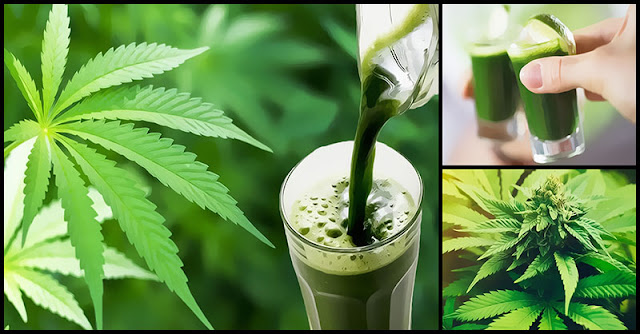Spinach and kale are not the only nutrient-packed leafy green plants that you can toss into your juicer. Yes! You’re right! You can also juice cannabis.
Why Cannabis?
Cannabis is commonly known as marijuana, weed, pot, reefer, and grass. Though this plant is currently illegal in many parts of the world, scientists have continued to study it, and people have continued to use it for both recreational and medicinal purposes.
More than 80 unique, biologically active cannabinoids have been identified in cannabis. Meta-analysis of these compounds showed that there are over a dozen therapeutic properties attributable to cannabinoids, including anti-cancer, anti-bacterial, neuroprotective, and anti-diabetic properties.
Benefits Without The Buzz
Raw cannabis contains many of the same nutrients as other leafy greens (like iron, calcium, and fiber). It is not psychoactive unless heated. Also, it is packed with cannabinoids, which are unique and powerful disease-fighting compounds.
According to MedicalJane, juiced cannabis is a nutritionally-dense, very potent medicine:
“The high concentration of raw cannabinoid acids in juiced cannabis coupled with the perfect balance of fatty acids could help improve cell function and reduce damage caused by free radicals. Additional benefits of raw, juiced cannabis include reduced inflammation and the facilitation of two-way cellular communication. Many cannabinoids also have anti-tumor properties which are readily available through the consumption of raw marijuana.”
“Some call cannabis the “most important vegetable on the planet” because it can assist the function of your immune system, provide anti-inflammatory benefits, and improve bone metabolism and neural function. In fact, research has shown medical marijuana is even capable of inhibiting cancer cell growth.”
Dr. William Courtney, a dietary raw cannabis specialist, explains the difference between smoking and consuming the plant:
“You are actually walking away from 99% of the benefits cannabis provides when you cook or smoke cannabis.”
“If you don’t heat marijuana, you can go up to five or six hundred milligrams and use the plant strictly as a dietary supplement by upping the anti-oxidant and neuro-protective levels which come into play at hundreds of milligrams of CBDA and THCA. It is this dramatic increase in dose from 10 mg of psychoactive THC to the 500 mg – 1,000 mg of non-psychoactive THCA, CBDA, and CBGA that comprises the primary difference between traditional medical marijuana treatments and using cannabis as a dietary supplement.”
“In its raw form, cannabis contains both THCA (tetrahydrocannabinolic-acid) and CBDA (cannabidiolic-acid), two cannabinoids known for their medicinal benefits. Each of those must be heated in order to produce THC and CBD.”
“Only when you decarboxylate THCA – turning it into THC – does it cause psychoactive effects or the “high” associated with smoking cannabis.”
“Because raw, juiced cannabis produces no high, it is possible to consume much larger amounts of beneficial cannabinoids. CBD has been shown to halt – or even reverse – the growth of certain cancers, but only in extremely high doses. The FDA has established a 600 mg daily allowance of CBDs, but only 10 mg or less for THC. Most cannabis strains contain less than .01 percent CBD and well over 10 percent THC, so reaching the 600 mg daily allowance for CBDs is impossible without juicing it first, according to PotGuide.com.”
The following conclusions were made by Dr. Courtney’s after his research on the benefits of raw cannabis:
- Therapeutic levels of cannabinoids are better achieved through ingestion
- Smoking cannabis may not treat the disease, only the symptoms
- Raw cannabis activates the brain’s cannabinoid system, which triggers an antioxidant release
- These antioxidants act as a “cleaner” and remove damaged cells from the body
- Raw cannabis improves the efficiency of the cells in our body
- When cannabis is heated or burned, the chemical structure of the plant compounds are changed, specifically the acidity of THC, which alters its ability to be therapeutic
- Creating oils, butter, or eating the raw plant is the best way to get the necessary beneficial compounds
According to Dr. Courtney, about 8,000 of his patients have seen positive effects from ingesting raw dietary cannabis, whether it’s blended, juiced, or chopped up and added to coleslaw.
“When it’s consumed as a leafy green vegetable, you get the whole profile of the plant. My experience day in and day out is overwhelmingly positive with patients who are using it.”
Courtney added that cannabis should be in everyone’s diet on a regular basis, just like any other leafy green veggies.
“You only need it as medicine when you have forgotten it is food.”
How To Create Cannabis Concoctions
First, a warning from MedicalJane:
“DO NOT go to your local dispensary, obtain dried cannabis, and throw your buds in the juicer thinking you’re about to make a magic healing potion. Juicing requires raw, freshly-picked and properly grown cannabis rid of any pesticides or other microbiological contaminants.”
“If you live in a state that allows personal marijuana cultivation, PotGuide.com says it is best to grow your own.”
Dr. Courtney recommends using the freshest plants possible.
Use 15 leaves and 2 large (2 to 4 inches) raw buds per day. Raw buds are flowers harvested when the THC glands are clear (rather than amber).
Place the leaves and buds in your juicer or blender. Be gentle if you are using a blender – blending on too high of a speed for too long will produce heat, which can activate some of the cannabinoids. Use short pulses, and if you are mixing in other ingredients, place them in the blender first to keep the cannabis leaves away from the blender’s blades.
Due to its strong flavor, many find cannabis juice unpleasant. To make it tastier, you can mix it with fruits or vegetables such as cucumber, carrot, or sweet potato (1-part cannabis juice to 5 parts of vegetable juice). You may consume the juice immediately or cover and store it for up to three days.
For optimum results, Dr. Courtney suggests consuming one cup of cannabis juice three times a day.









